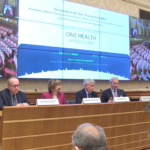The Middle East’s protracted conflicts have caused a region-wide health crisis that goes beyond war wounds to heightened resistance to antibiotics and a collapse in vaccination drives, leading to a resurgence of diseases tamed in peacetime. Health threats are so varied that one of the Middle East’s main teaching hospitals, the American University of Beirut Medical Center (AUBMC), has introduced a conflict-medicine program to equip students to cope in an environment afflicted by chaos. As fighting has engulfed Syria, Iraq, Yemen and Libya since 2011, doctors and nurses have had to adjust not only to treating terrible injuries but to a faster spread of disease and growing threats to their own safety from combatants. Doctors, universities and aid agencies must respond by sharing experience and expertise, and by adapting research and medical practices, said participants at a conflict medicine conference at AUBMC, pointing out that Lebanon’s doctors have had their share of experience in conflict medicine due to the 1975-1990 civil war. The conference was held a few hundred meters from the iconic Beirut building that is witness to the war with its riddled facade. One growing problem is the disruption of vaccinations. Ali Batarfi, dean of the Hadramawt College of Medicine in Mukalla, Yemen, described a recrudescence of dengue fever that had been comparatively rare before the war there. Yemen is suffering from a cholera outbreak after more than two years of a war that has crippled public services, fostered malnutrition, hindered the import of adequate medical supplies and hobbled hospital capacity with war injuries. The collapse in national health systems has accelerated resistance to antibiotics because of drug usage in excess of prescribed limits. At the same time, infections have spread as war has destroyed sanitation and clean water systems and triggered chaotic population movements. The impact ripples beyond countries at war. Lebanon’s health system has grappled with the extra patients from around the war-ridden region attending its hospitals, including some from the more than one million Syrian refugees now in the country. A fifth of patients at AUBC are from Syria and Iraq, of whom the overwhelming majority suffered from war wounds, though the burns department noted a big rise in cases among children because of tent fires in refugee camps. Doctors in war zones have had to radically alter their approach, rationing resources, operating in primitive conditions and changing the way they treat trauma injuries. Surgical treatment of injuries is very different when those wounds have been caused by high-velocity bullets or shrapnel – something traditionally trained surgeons must learn as war has spread in the Middle East. Increasingly, warring sides in conflicts are targeting medical facilities, seemingly aiming to reduce their enemies’ stomach for battle by aggravating the suffering of civilians. “When I started for MSF, my MSF jacket was my bullet-proof vest”, said Dr Anja Wolz, emergency coordinator at Medecins Sans Frontieres in Brussels, who has worked recently at the MSF field hospital in Mosul. “Now you feel like a target”. The ICRC has warned that the drawn-out crises plaguing the Middle East “could lead to the total collapse of health systems”.







